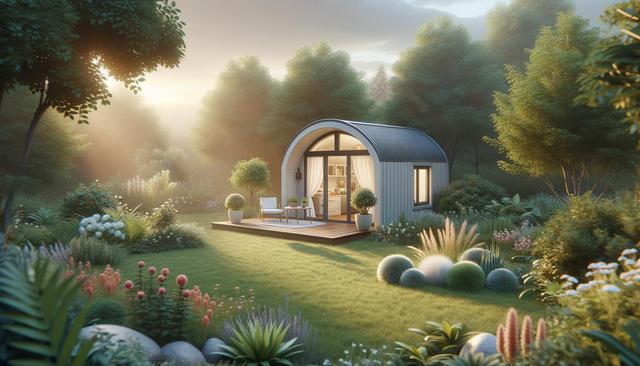What Are Granny Pods and Why Are They Gaining Popularity?
Granny pods, also known as accessory dwelling units (ADUs), are small, self-contained living spaces designed to be placed in a backyard. These structures are particularly useful for families who want to provide independent, yet nearby, living arrangements for elderly relatives. In recent years, the interest in affordable granny pods has grown significantly due to changing family dynamics, an aging population, and the rising costs of assisted living facilities.
Granny pods typically include essential amenities such as a bedroom, bathroom, kitchenette, and sometimes even a small living area. Their compact size makes them easier and quicker to install compared to traditional home additions. Moreover, many people find them to be a more personal and dignified alternative to senior care centers.
Some of the key benefits of granny pods include:
- Maintaining family proximity while ensuring privacy
- Cost-effective compared to long-term care facilities
- Customizable features to accommodate medical needs
- Increased property value
These benefits make granny pods a compelling option for multi-generational households seeking a balance between independence and support.
Cost Considerations and What Makes a Granny Pod Affordable
The affordability of a granny pod can vary widely depending on size, features, materials, and location. However, there are several strategies to ensure the project remains within a reasonable budget. One major factor is choosing a prefab granny pod, which often reduces labor and material costs due to factory-controlled production.
When evaluating affordable options, consider the following cost-saving elements:
- Modular or pre-designed units rather than custom builds
- Basic or minimal interior finishes
- Energy-efficient materials and appliances
- Local building codes and permit requirements
Prices for budget-friendly granny pods can range from under $20,000 for a very basic unit to upwards of $50,000 for more complete setups. While this may seem high, the long-term savings on elder care and the added home value often offset the initial investment.
Financing options such as home equity loans, personal loans, or specific ADU financing programs can also make the initial cost more manageable for homeowners.
Design Features That Support Independent Living
Affordability doesn’t have to mean compromising on comfort or accessibility. Many affordable granny pods are designed with features that support the independence and safety of older adults. These include wide doorways, walk-in showers, non-slip flooring, and accessible kitchen layouts.
Key design considerations for a functional granny pod may include:
- Single-floor layout to eliminate stairs
- Grab bars and handrails in strategic locations
- Bright lighting and large windows for visibility
- Smart home features for monitoring and communication
For those with specific medical needs, some granny pods can be equipped with health-monitoring technology and emergency response systems. These additions help ensure that aging family members can live safely and independently while still being close to loved ones.
It’s also possible to modify existing backyard structures into livable granny pods with the right renovations, making this a flexible and scalable solution for various budgets and needs.
Legal and Zoning Considerations
Before installing a granny pod, it’s essential to understand the local zoning laws and building regulations. Not all municipalities allow accessory dwelling units, and those that do may have specific requirements about size, placement, and occupancy.
Important legal factors to consider include:
- Permits: Most jurisdictions require a building permit for granny pods
- Zoning: Some areas restrict ADUs to certain residential zones
- Utility connections: Regulations on water, sewage, and electricity hookups
- Property setbacks: Rules about how close to the property line a unit can be placed
Some cities have streamlined their laws to encourage more ADU construction, often as part of broader affordable housing strategies. Homeowners should consult with local planning departments or hire a contractor familiar with ADU regulations to ensure compliance and avoid costly mistakes.
Understanding these factors early in the planning process can help prevent delays and additional expenses, making the path to installing an affordable granny pod smoother and more predictable.
Making the Right Choice for Your Family
Choosing to install a granny pod is a significant decision that requires careful consideration of your family’s needs, budget, and long-term plans. While the upfront costs may seem substantial, many families find that the benefits—increased family cohesion, reduced elder care costs, and enhanced property value—far outweigh the investment.
To make an informed choice, consider the following steps:
- Assess your loved one’s current and future care needs
- Research local laws and permit requirements
- Establish a realistic budget and explore financing options
- Compare different models and features for affordability and functionality
- Work with professionals to design and install the unit properly
Granny pods offer a practical and compassionate solution for families looking to support aging relatives while preserving independence and dignity. With thoughtful planning and attention to detail, it’s possible to create a comfortable and cost-effective living space right in your backyard.
Conclusion: A Practical Step Toward Family-Centered Living
Affordable granny pods are an increasingly viable option for families seeking to care for elderly members without the high costs of traditional care facilities. By understanding the costs, legal considerations, and design features, homeowners can make informed decisions that benefit both their loved ones and their property. With growing interest and supportive developments in housing policies, granny pods are not just a trend—they’re a long-term solution for multi-generational living that balances independence and connectedness.


Leave a Reply